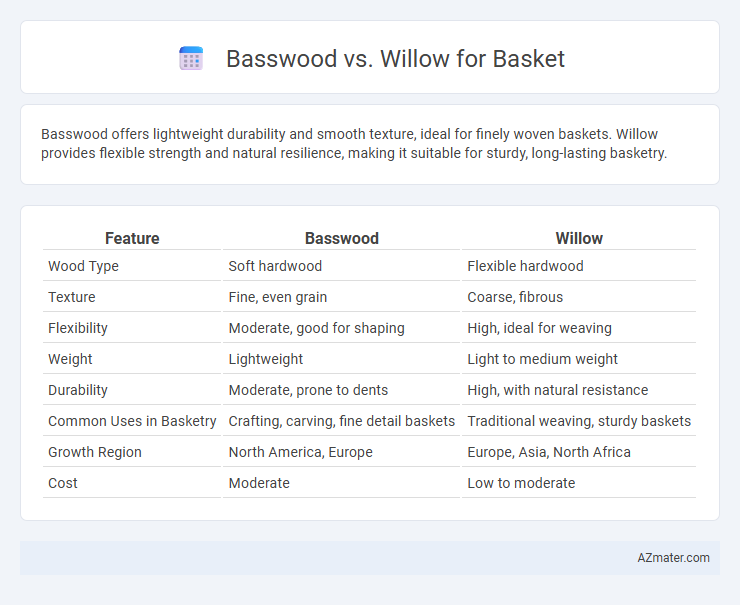Basswood offers lightweight durability and smooth texture, ideal for finely woven baskets. Willow provides flexible strength and natural resilience, making it suitable for sturdy, long-lasting basketry.
Table of Comparison
| Feature | Basswood | Willow |
|---|---|---|
| Wood Type | Soft hardwood | Flexible hardwood |
| Texture | Fine, even grain | Coarse, fibrous |
| Flexibility | Moderate, good for shaping | High, ideal for weaving |
| Weight | Lightweight | Light to medium weight |
| Durability | Moderate, prone to dents | High, with natural resistance |
| Common Uses in Basketry | Crafting, carving, fine detail baskets | Traditional weaving, sturdy baskets |
| Growth Region | North America, Europe | Europe, Asia, North Africa |
| Cost | Moderate | Low to moderate |
Introduction to Basket Weaving Materials
Basswood and willow are popular materials in basket weaving due to their flexibility and durability. Basswood offers a smooth texture and lightweight quality, making it ideal for fine, detailed weaving projects. Willow provides robust strength and natural resilience, perfect for sturdy, functional baskets that require long-lasting performance.
Overview of Basswood and Willow
Basswood and willow are popular materials for basket weaving due to their flexibility and strength. Basswood features soft, lightweight fibers with a fine grain, making it easy to split and shape for intricate basket designs. Willow offers greater durability and a slightly coarser texture, ideal for creating sturdy, functional baskets that can withstand heavy use.
Physical Properties: Basswood vs Willow
Basswood features a lightweight, fine-grained texture that makes it easy to carve and shape, while willow offers greater flexibility and toughness, ideal for weaving intricate basket patterns. Basswood's pale color and smooth surface provide a clean finish, whereas willow's fibrous, slightly rough texture enhances grip and durability. Both woods exhibit good moisture resistance, but willow generally handles bending stresses better, making it the preferred choice for resilient, tightly woven baskets.
Workability and Flexibility Comparison
Basswood offers exceptional workability due to its fine, even grain that allows for smooth cutting and shaping, making it ideal for intricate basket weaving. Willow stands out for its superior flexibility and pliability, enabling bendable, durable basket structures without cracking. While basswood provides ease in detailed craftsmanship, willow excels in creating resilient, flexible basket frameworks.
Durability and Longevity in Basketry
Basswood offers superior durability for basketry due to its dense, fine-grained texture that resists wear and maintains structural integrity over time. Willow, while flexible and lightweight, is more prone to splitting and degradation with prolonged exposure to moisture and handling. For baskets intended to endure heavy use or last several years, basswood provides greater longevity and resilience compared to willow.
Aesthetic Differences in Finished Baskets
Basswood baskets exhibit a smooth, pale, and consistent texture that enhances a clean and refined aesthetic, ideal for minimalist and elegant designs. Willow baskets feature a natural, rustic appearance with visible grain variations and earthy tones, giving them a traditional and handcrafted charm. The choice between basswood and willow affects the basket's visual warmth and style, influencing its suitability for modern versus rustic decor.
Sourcing and Sustainability of Basswood and Willow
Basswood is primarily sourced from North American deciduous forests, known for its rapid growth and minimal pesticide use, making it a sustainable choice for basket crafting. Willow, often harvested from European and Asian wetlands, regenerates quickly through coppicing, allowing for repeated harvesting without replanting, which supports sustainable forestry practices. Both materials provide eco-friendly options, but willow's ability to thrive in wetlands offers unique environmental benefits alongside basswood's low-impact cultivation.
Cost and Availability for Basket Makers
Basswood is generally more affordable than willow, making it a cost-effective choice for basket makers focused on budget-friendly materials. Willow offers greater availability in regions with wet climates, as it thrives in such environments, while basswood is more common in temperate hardwood forests and may require sourcing from specialty suppliers. The ease of procurement and lower price of basswood often make it the preferred option for hobbyists and small-scale artisans compared to the sometimes seasonal and pricier willow.
Traditional and Modern Uses in Basket Weaving
Basswood offers lightweight, fine-grained fibers favored in traditional basket weaving for its flexibility and strength, ideal for intricate patterns and durable baskets. Willow, known for its tough, pliable branches, excels in both traditional and modern basketry, providing resilience and moisture resistance for functional and decorative designs. Modern artisans often blend basswood's smooth texture with willow's sturdy framework to create innovative, long-lasting baskets that honor heritage techniques while meeting contemporary aesthetic and practical needs.
Choosing the Best Wood: Basswood or Willow?
Basswood offers a lightweight, smooth texture ideal for fine, detailed weaving, while willow provides superior flexibility and durability, making it perfect for sturdier baskets. Choosing between basswood and willow depends on the basket's intended use; basswood is best suited for decorative or delicate designs, whereas willow excels in functional, load-bearing baskets. Considering factors like pliability, strength, and finish will guide crafters in selecting the optimal wood for their basket projects.

Infographic: Basswood vs Willow for Basket
 azmater.com
azmater.com